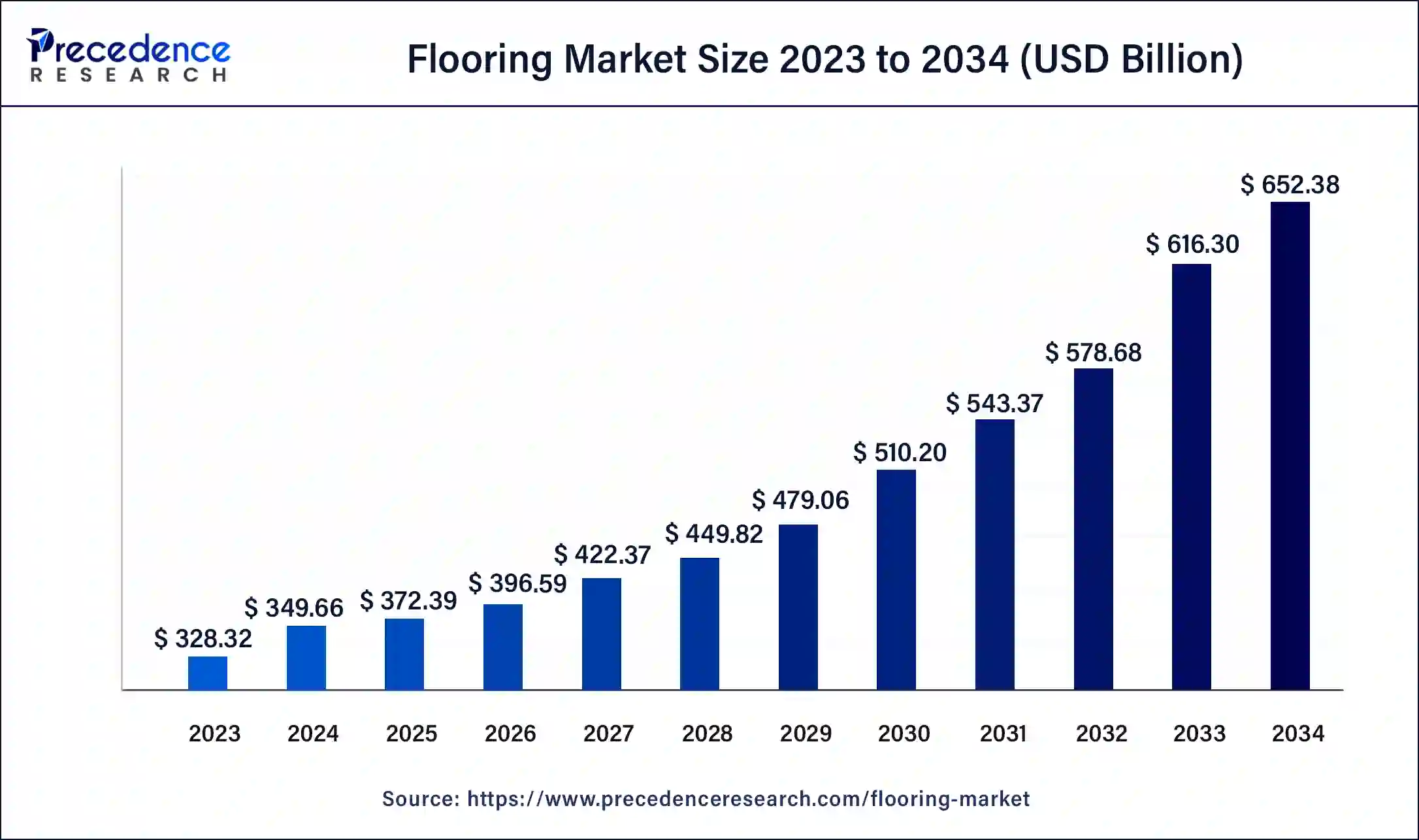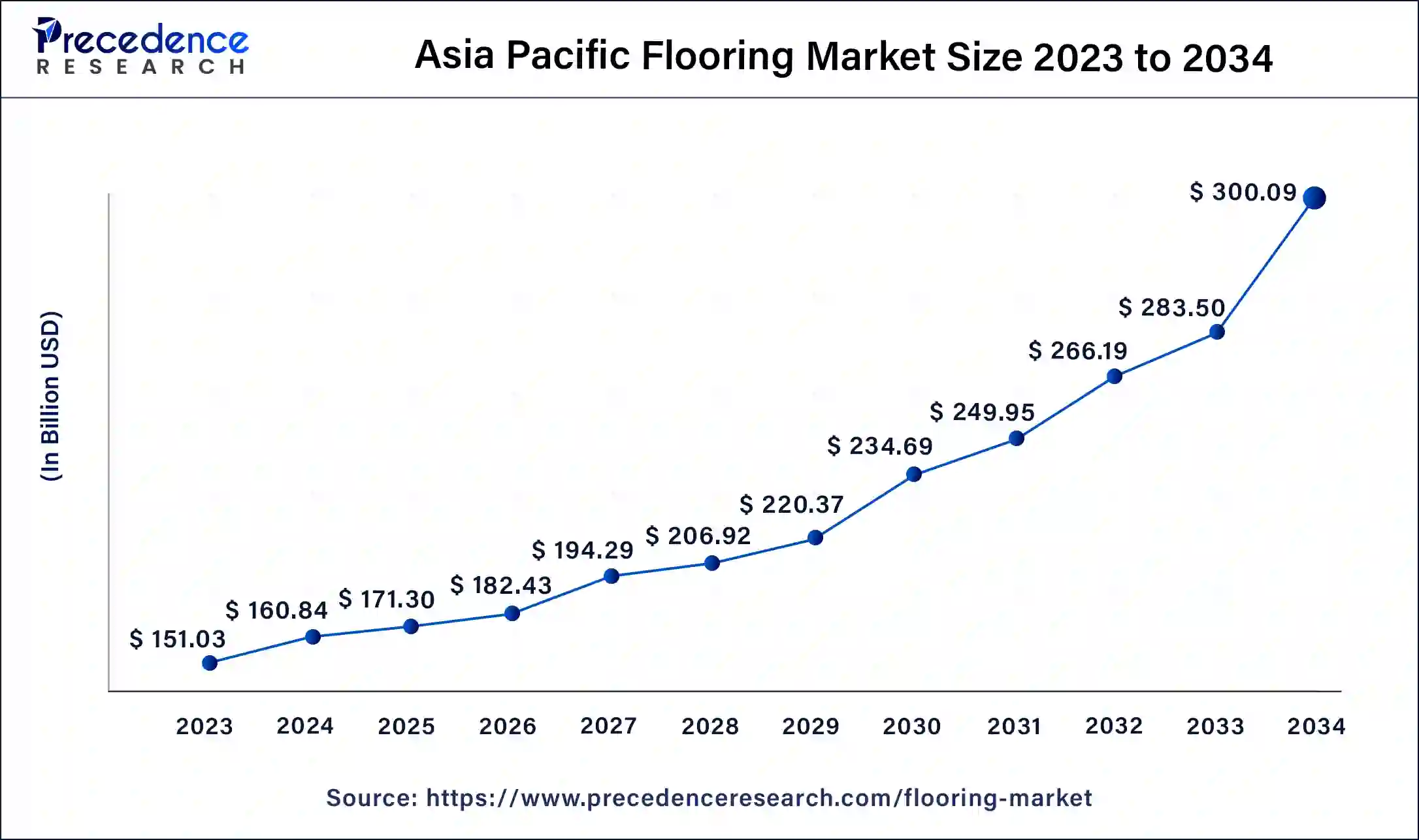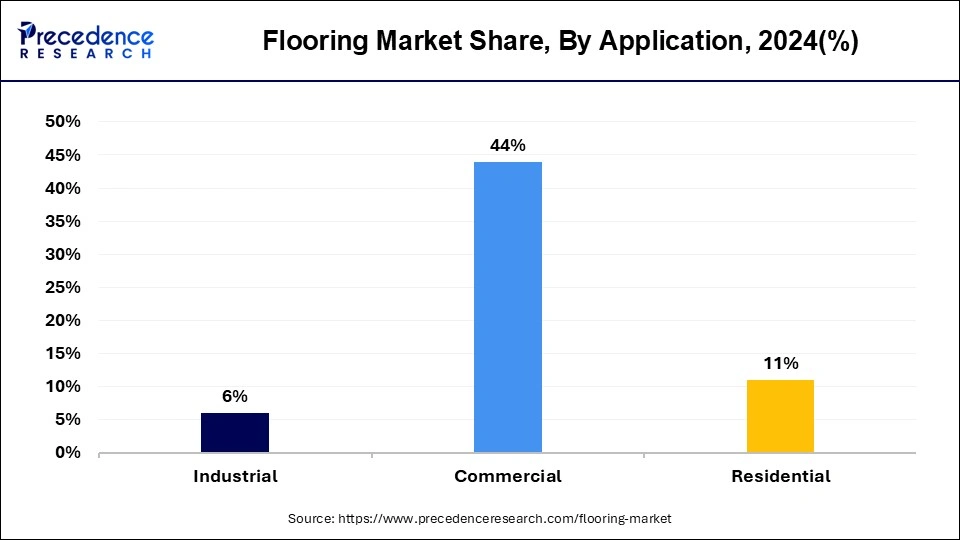List of Contents
Flooring Market Size and Forecast 2025 to 2034
The global flooring market size accounted for USD 349.66 billion in 2024 and is expected to reach around USD 652.38 billion by 2034, expanding at a CAGR of 6.5% from 2025 to 2034.

Flooring Market Key Takeaways
- Asia Pacific region captured more than 46% of revenue share in 2024.
- By Product, the vitrified (porcelain) tiles segment generated more than 28% of revenue share in 2024.
- By Application, the residential segment was dominated and contributed more than 50% of the total revenue share in 2024.
- By Application, the commercial segment recorded more than 44% of the total revenue share in 2024.
- By Type, the non-resilient segment generated more than 62% of total revenue in 2024.
- By Type, the resilient segment accounted for around 15% of the total market in 2024.
Asia Pacific Flooring Market Size and Growth 2025 to 2034
The Asia Pacific flooring market size was estimated at USD 160.84 billion in 2024 and is predicted to be worth around USD 300.09 billion by 2034, at a CAGR of 6.7% from 2024 to 2034.

Asia Pacific region has generated the highest revenue share in 2024, and it is projected to maintain its leading position and grow at a faster rate than other regions in the flooring market. This can be attributed to the increasing investments and construction policies in countries such as China, India, furthermore Southeast Asia. Moreover, the rapid industrialization in the region is expected to drive the market further, with China leading the market growth due to increasing the population with the need for infrastructure and new buildings.
Currently, Asia Pacific is dominating the flooring market globally. The economic growth of China enables the developmental growth. Furthermore, the increased rate of urbanization and the accelerating investment rate in commercial and residential verticals make the region the highest in innovation.
In Europe, the growing use of ceramics and also vinyl in non-residential buildings is expected to drive growth, along with rising consumer expenditure and the preference for luxurious living spaces.
The Middle East & Africa market is projected to grow due to rising the demand for floor coverings from ongoing construction projects.
The flooring market in India is fueled by strong expansion in the construction and real estate industries. Key factors include the increase in residential buildings, urban growth, and government programs such as Housing for All that have heightened demand. The use of advanced materials like vinyl and laminated flooring, recognized for their resilience and affordability, has further aided the consistent growth of this market. Market demand is mainly driven by swift urbanization and the development of retail spaces, especially in major cities.

In North America, the market is expected to grow due to rising the demand for healthcare facilities, luxurious houses, and commercial buildings. In South America, the market is projected to see major growth due to the growing renovation and remodeling activities in private and multi-story houses.
Environmentally friendly and sustainable flooring choices are gaining more popularity in the German flooring industry. As individuals grow more aware of environmental concerns, the need for products created from renewable resources is increasing. This trend aligns with Germany's commitment to sustainability, evident through several initiatives aimed at reducing carbon emissions.
Market Overview
Flooring refers to a type of surface material that is applied over the floor and subfloor formation to provide a smooth and safe foot surface. Products are known for their resistance to dents, scratches, and moisture, making them easy to clean and maintain. Popular flooring products include vinyl tiles, ceramic tiles, carpets, also laminates, which offer a clean, hard, and visually appealing surface to floors. As a result, consumers widely use these products during the construction and renovation of both residential and non-residential buildings.
Flooring Market Growth Factors
Several factors such as the growth of the construction industry, increasing disposable income, and rising demand for eco-friendly and sustainable flooring materials drive the market. The industry is highly competitive, and numerous players offer a wide array of flooring products at different price points.
The flooring market is expected to grow due to several growth factors. Here are the key factors driving the growth of the flooring market:
- Growth of the construction industry: The construction industry is a significant driver of the flooring market. As new residential and commercial buildings are built, there is an increased demand for flooring materials. Additionally, as existing buildings are renovated or remodeled, new flooring products are needed.
- Rising disposable income: With an increase in disposable income, people are more likely to invest in their homes and improve their living conditions. Flooring is one way to do this, as new flooring can update and modernize a home's interior.
- Increasing demand for eco-friendly and sustainable flooring materials: With growing concerns over climate change, there is an increasing demand for eco-friendly and sustainable flooring materials. Consumers are seeking out products that are made from renewable materials and have a low environmental impact.
- Technological advancements in flooring products: Flooring manufacturers are continuously innovating and developing new products with better properties such as durability, ease of installation, and design. Technological advancements in flooring products have led to the development of products that are easier to install, require less maintenance, and have a longer lifespan.
- Growing urbanization: Urbanization is driving demand for flooring products, especially in emerging markets. As more people move to cities, there is an increased need for new housing, commercial buildings, and infrastructure, all of which require flooring.
- Increasing demand for luxury flooring products: With rising income levels, there is an increasing demand for luxury flooring products. Premium flooring materials, such as hardwood or high-end ceramic tile, are becoming more popular among consumers who want to make a statement with their home decor.
- Overall, the flooring market is expected to grow due to a combination of these factors. As new construction and renovation projects increase, demand for flooring materials will continue to rise, and manufacturers will continue to innovate and develop new products to meet consumer demand.
Technological Advancement
Technological advancement in the flooring market highly depends on innovation and creativity in designs, materials, and installation processes. It will lead to the development of supporting smart solutions, digital printing, and waterproof technology. Digital printing technology is at its highest demand. This technology helps with difficult designs, along with the textures on flooring materials. Tools like 3D printing and augmented reality have led to an improvement in installation, maintenance, and design. Natural materials such as marble, hardwood, and stone complement digital printing. Additionally, the spatial intelligence data analytics contributes to installing patented floor sensors. It's a part of modern technology.
Designer trends in flooring have advanced and approached certain styles, such as minimalist and Scandinavian, enabling customers to choose. The fancy customer demands of natural materials and light colors highly influence the flooring market. The installation and maintenance features include locking system technology. It's an innovative technology. With the Unidrop and drop-lock system, vinyl flooring installation became faster and easier. The latest popular technology is vinyl flooring. It's tough, rigid core benefits lamination and flooring. It can be installed on flat surfaces as well as uneven surfaces.
Market Scope
| Report Coverage | Details |
| Market Size by 2034 | USD 652.38 Billion |
| Market Size in 2025 | USD 372.39 Billion |
| Market Size in 2024 | USD 349.66 Billion |
| Growth Rate from 2025 to 2034 | CAGR of 6.5% |
| Largest Market | Asia Pacific |
| Base Year | 2024 |
| Forecast Period | 2025 to 2034 |
| Segments Covered | By Product, By Application, and By Type |
| Regions Covered | North America, Europe, Asia-Pacific, Latin America, and Middle East & Africa |
Market Dynamics
Drivers
The market is expected to be driven by the growing demand for vinyl flooring in both residential and non-residential buildings
Vinyl is a versatile material commonly used in tiling applications, with luxury vinyl tile being the most popular. It is ideal for applications where spills are a concern, as it is moisture and mold resistant. Furthermore, due to its affordability, ease of installation, and durability, it is becoming increasingly popular as a finishing material in both residential and non-residential buildings. As a result, the growing use of vinyl in these types of buildings is expected to drive the growth of the flooring market.
Rising requirements for multi-storey buildings to further drive the demand for flooring products
The demand for multistory buildings has increased in both the residential and commercial sectors, with population growth and rising consumer expenditure driving demand for multistory residential buildings. Meanwhile, the growth of commercial multistory buildings is attributed to the increasing industrialization and urbanization in developing economies. Furthermore, government initiatives to build smart cities are expected to further drive market demand. The rapidly expanding real estate sector has also contributed to the growth of multistory buildings. Consequently, these favorable factors are expected to drive the demand for tiling during the forecast period.
Key Market Challenges
The flooring market faces several challenges that can impact its growth in the coming years
- Environmental concerns: The flooring industry is facing increasing scrutiny over its environmental impact. The production and disposal of certain types of flooring materials can have negative effects on the environment, which can impact the industry's reputation and market demand. As a result, the market is shifting towards eco-friendly and sustainable flooring materials, which can be more expensive to produce and may not be as widely available as traditional flooring options.
- Fluctuations in raw material prices: The flooring market is heavily dependent on the prices of raw materials such as wood, carpet fibers, and chemicals used to make various types of flooring. Any fluctuations in the prices of these materials can directly impact the cost of production and ultimately, the prices of finished products. This can affect consumer demand and may also result in manufacturers shifting to alternative materials or reducing the quality of their products to maintain profitability.
- Intense competition: The flooring market is highly competitive, with a large number of players offering a wide range of products at different price points. This can make it difficult for newer or smaller companies to gain a foothold in the market. Additionally, the lack of product differentiation can also lead to price wars, which can negatively impact profit margins and the overall market.
Key Market Opportunities
- Increasing demand for green flooring: The increasing awareness about the impact of flooring on the environment has led to rising demand for eco-friendly and sustainable flooring materials. This presents a significant opportunity for manufacturers to develop and offer green flooring options that cater to this growing segment of environmentally conscious consumers.
- Technological advancements: Advancements in technology, such as 3D printing, can be leveraged to create unique and customizable flooring options that offer a competitive advantage to manufacturers. Additionally, the use of digital tools such as virtual reality for product visualization and augmented reality for installation can also enhance the customer experience.
Product Insights
The vitrified (Porcelain) tiles segment had the highest revenue share in 2024, due to their superior properties such as greater strength and durability compared to general ceramic tiles. Porcelain tiles those made from ultrafine and dense clays and fired at extreme temperatures, making them more resistant to mold, bacteria, and fading. The ceramic tiles segment accounted for 21.8% of revenue in2024, with three primary types including glazed, unglazed, and scratch-resistant tiles.
The scratch-resistant tile is popular for use in high-traffic areas. The wood & laminate segment is expected to grow substantially in the coming years, with an estimated value of USD 51.2 billion in 2024. The increasing significance of wood in luxury construction for both residential and commercial areas is driving this growth, with benefits including durability, strength, high monetary value, easy maintenance, aesthetics, steady appearance, option for improved acoustics, refinishing, and improved air quality.
The natural stone segment is comparatively expensive but extensively used for its durability, lasting value and beauty. This segment includes marble, granite, limestone, sandstone, quartzite, and other materials. These stones are popular in bathrooms, hallways, living areas, and outdoor spaces. Due to the growing demand for natural stones, those companies are investing more to strengthen their position in the market.
Application Insights
In2024, the flooring market was dominated by the residential application segment. This segment includes various types of residential buildings such as complexes, apartments, and small houses. The growth of the residential sector has been positively impacted by government subsidies for first-time homebuyers in both developing and developed economies.

Furthermore, many countries in the Asia Pacific have introduced diverse schemes to prop up the development of the real estate sector. Those schemes are either partially or fully funded by the governments in the countries, in turn, benefit the demand side of the construction sector. This is expected to drive the growth of the flooring market in the coming years.
In 2024, the commercial applications segment held a significant revenue share. These applications are often in high area traffic so require very durable flooring options like resilient and wooden flooring. The flooring product is widely used in various commercial buildings, including shopping malls and other types of retail stores.
The increasing construction of commercial buildings, such as big-box stores, drugstores, and grocery stores, in recent years, is expected to drive growth in this segment in the upcoming years. Additionally, there is a robust demand for office spaces, particularly in the urban areas of emerging economies, which is also driving the demand for high-quality flooring products.
Type Insights
The non-resilient type of flooring held the dominant position in the market. This growth can be attributed to the increasing construction activities in developing countries, driven by population growth and industrial activities. The non-resilient flooring segment is expected to continue leading the market during the forecast period, thanks to its water resistance and long-term durability.
The resilient type of flooring accounted for 15% of the total market in2024, mainly due to its growing use in commercial buildings such as gyms, offices, fitness centers, and hospitality buildings. Resilient flooring is durable and cost-effective, with low maintenance costs, and is comfortable to walk on due to its density and non-absorbent nature.
Several types of synthetic floorings, such as vinyl sheet flooring, planks, vinyl composition tile, luxury vinyl tiles, rubber, linoleum, and cork are also available in roll and tile forms. Manufacturers also offer color and texture customization, which is expected to drive the market's growth.
Flooring Market Companies
- Mohawk Industries
- Shaw Industries
- Tarkett Group
- Armstrong Flooring
- Forbo Holding AG
- Interface Inc.
- Mannington Mills
- Congoleum Corporation
- Beaulieu International Group
- Gerflor Group
Recent Developments
- In January 2025, Empire Today, LLC, a frontrunner in direct-to-consumer flooring, established a new benchmark for residential flooring projects with an enhanced in-home shopping experience, Empire's Home Floor Advantage™. Empire Today dedicated several months to exploring different ways for consumers to buy flooring and has developed this customer-centric approach grounded in feedback and insights that highlight what maximizes product satisfaction and enhances the experience.
- In April 2025, ReCoat Revolution, the top company in quick and tidy floor refinishing, revealed the grand opening of its latest branch in South Charlotte, North Carolina. Through its groundbreaking "Clean" method for floor restoration, ReCoat Revolution offers homeowners and businesses an effortless way to rejuvenate their floors without the mess, dust, or delays tied to conventional refinishing techniques.
- In June 2025, Concrete Shield Coatings, a surface treatment and protection company based in Northbrook, announced the launch of its high-quality epoxy flooring solutions intended for residential and commercial use. This deliberate service extension demonstrates increasing need for durable, low-maintenance flooring solutions that can endure diverse environmental and operational circumstances.
- In January 2020, Mannington unveiled new sheet vinyl designs including Miramar, which was added to Revive. Miramar incorporates the latest Glam/Luxe trend and is characterized by a distinctive diamond geometric pattern with subtle veining and soft color variation.
- In September 2024, Vebro Polymers and Thermax partner to dive into the Indian industrial and commercial flooring market.
In January 2025, LX Hausys highlighted its flooring materials at the U.S. fair. The company's second appearance at the exhibition added an innovative touch to the flooring market.
Segments Covered in the Report
By Product
- Ceramic Tiles
- Vitrified (Porcelain) Tiles
- Carpet
- Vinyl
- Luxury Vinyl Tiles (LVT)
- Linoleum/Rubber
- Wood & Laminate
- Natural stone
- Other Flooring Materials
By Application
- Residential
- Commercial
- Industrial
By Type
- Resilient Flooring
- Soft Coverings
- Non-Resilient Floorings
- Seamless Flooring
By Region
- North America
- Europe
- Asia-Pacific
- Latin America
- Middle East and Africa
For inquiries regarding discounts, bulk purchases, or customization requests, please contact us at sales@precedenceresearch.com
Frequently Asked Questions
Ask For Sample
No cookie-cutter, only authentic analysis – take the 1st step to become a Precedence Research client